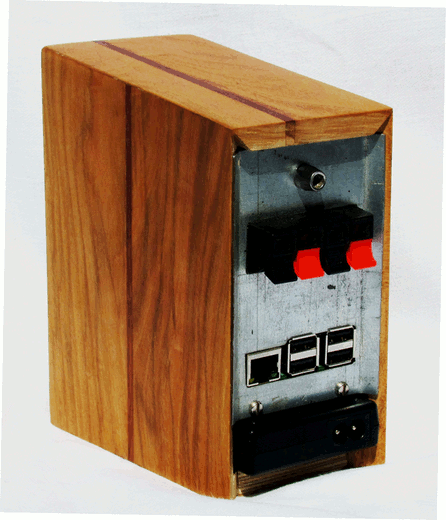Something I wanted to share is a device I recently built. It is a complete net player for music files, served by a NAS. It’s now finished and “in production” now, so here is my report. [caption id=“attachment_616” align=“alignleft” width=“595”] The cherry ear net player, based on raspberry pi and HifiBerry Amp+.[/caption]
The cherry ear net player, based on raspberry pi and HifiBerry Amp+.[/caption]
Hardware
The device is based on a Raspberry Model B+ with a HifiBerry Amp+. [caption id=“attachment_618” align=“alignleft” width=“446”] Cherry Ear backside with connectors and power supply[/caption]The Amp+ is a high-quality power amplifier that is mounted on the Raspberry mini computer, shortcutting the sub optimal audio system of the raspy. Only loudspeakers need to be connected, and this little combination is a very capable stereo audio system.
Cherry Ear backside with connectors and power supply[/caption]The Amp+ is a high-quality power amplifier that is mounted on the Raspberry mini computer, shortcutting the sub optimal audio system of the raspy. Only loudspeakers need to be connected, and this little combination is a very capable stereo audio system.
Software: Volumio
On the Raspberry runs a specialised linux distribution with a web based audio player for audio files and web radio. The name of this project is Volumio and it is one of my most favorite projects currently. What I like with it is that it is only a music player, and not a project that tries to manage all kind of media. Volumios user interface is accessible via web browser, and it is very user friendly, modern, pretty and clean.
It works on all size factors (from mobile phone to desktop) and is very easy to handle. Its a web interface to mpd which runs on the raspi for the actual music indexing and playing.
[caption id=“attachment_619” align=“alignleft” width=“400”] Volumio User Interface[/caption]The distribution all is running on is an optimized raspbian, with a variety of kernel drivers for audio output devices. Everything is pre configured. Once the volumio image is written to SD-Card, the Raspberry boots up and the device starts to play nicely basically after network and media source was configured through the web interface.
Volumio User Interface[/caption]The distribution all is running on is an optimized raspbian, with a variety of kernel drivers for audio output devices. Everything is pre configured. Once the volumio image is written to SD-Card, the Raspberry boots up and the device starts to play nicely basically after network and media source was configured through the web interface.
It is impressive how the Volumio project aims for absolute simplicity in use, but also allows to play around with a whole lot of interesting settings. A lot can be, but very little has to be configured.
Bottomline: Volumio is really a interesting project which you wanna try if you’re interested in these things.
The Housing
I built the housing out of cherry tree from the region here. I got it from friends growing cherries, and they gave a few very nice shelfs. It was sliced and planed to 10mm thickness. The dark inlay is teak which I got from 70’s furniture that was found on bulky waste years ago.
After having everything cut, the cherry wood was glued together, with some internal help construction from plywood. After the sanding and polishing, the box was done.
[caption id=“attachment_621” align=“alignright” width=“300”] Sizes [cm][/caption]The Raspberry and Hifiberry are mounted on a little construction attached to the metal back cover, together with the speaker connector. The metal cover is tightend with one screw, and the whole electronics can be taken off the wood box by unscrewing it.
Sizes [cm][/caption]The Raspberry and Hifiberry are mounted on a little construction attached to the metal back cover, together with the speaker connector. The metal cover is tightend with one screw, and the whole electronics can be taken off the wood box by unscrewing it.
At the bottom of the device there is a switching power supply that provides the energy for the player.
How to Operate?
The player is comletely operated from the web interface. The make all additional knobs and stuff superflous, the user even uses the tablet or notebook to adjust the volume. And since the device is never switched off, it does not even have a power button.
I combined it with Denon SC-M39 speakers. The music files come from a consumer NAS in the home network. The Raspberry is very well powerful enough for the software, and the Hifiberry device is surprisingly powerful and clean. The sound is very nice. Clear and fresh in the mid and heights, but still enough base, which never is annoying blurry or drones.
I am very happy about the result of this little project. Hope you like it :-)